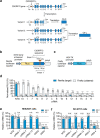This is a preprint.
A high-fidelity CRISPR-Cas13 system improves abnormalities associated with C9ORF72-linked ALS/FTD
- PMID: 38168370
- PMCID: PMC10760048
- DOI: 10.1101/2023.12.12.571328
A high-fidelity CRISPR-Cas13 system improves abnormalities associated with C9ORF72-linked ALS/FTD
Update in
-
A high-fidelity CRISPR-Cas13 system improves abnormalities associated with C9ORF72-linked ALS/FTD.Nat Commun. 2025 Jan 8;16(1):460. doi: 10.1038/s41467-024-55548-5. Nat Commun. 2025. PMID: 39779681 Free PMC article.
Abstract
An abnormal expansion of a GGGGCC hexanucleotide repeat in the C9ORF72 gene is the most common genetic cause of amyotrophic lateral sclerosis (ALS) and frontotemporal dementia (FTD), two debilitating neurodegenerative disorders driven in part by gain-of-function mechanisms involving transcribed forms of the repeat expansion. By utilizing a Cas13 variant with reduced collateral effects, we developed a high-fidelity RNA-targeting CRISPR-based system for C9ORF72-linked ALS/FTD. When delivered to the brain of a transgenic rodent model, this Cas13-based platform effectively curbed the expression of the GGGGCC repeat-containing RNA without affecting normal C9ORF72 levels, which in turn decreased the formation of RNA foci and reversed transcriptional deficits. This high-fidelity Cas13 variant possessed improved transcriptome-wide specificity compared to its native form and mediated efficient targeting in motor neuron-like cells derived from a patient with ALS. Our results lay the foundation for the implementation of RNA-targeting CRISPR technologies for C9ORF72-linked ALS/FTD.
Conflict of interest statement
CONFLICT OF INTERESTS T.G. and J.P. previously filed a patent application on technologies used in this manuscript. T.G., T.X.M and C.L have filed an initial disclosure related to the approach described in this study.
Figures




References
-
- Rowland L.P. & Shneider N.A. Amyotrophic lateral sclerosis. N. Engl. J. Med. 344, 1688–1700 (2001). - PubMed
-
- Lillo P., Savage S., Mioshi E., Kiernan M.C. & Hodges J.R. Amyotrophic lateral sclerosis and frontotemporal dementia: a behavioural and cognitive continuum. Amyotroph. Lateral Scler. 13, 102–109 (2012). - PubMed
-
- Lomen-Hoerth C., Anderson T. & Miller B. The overlap of amyotrophic lateral sclerosis and frontotemporal dementia. Neurology 59, 1077–1079 (2002). - PubMed
-
- Ringholz G.M. et al. Prevalence and patterns of cognitive impairment in sporadic ALS. Neurology 65, 586–590 (2005). - PubMed
-
- Pasquier F. & Petit H. Frontotemporal dementia: its rediscovery. European Neurology 38, 1–6 (2007). - PubMed
Publication types
Grants and funding
LinkOut - more resources
Full Text Sources
Miscellaneous
